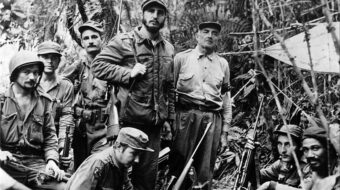
WASHINGTON – In a ceremony here marking the official re-opening of diplomatic relations between the U.S. and Cuba, Cuban Foreign Minister Bruno Rodriguez raised his nation’s flag in front of the Cuban embassy building here.
Later he said, “Only the lifting of the economic, commercial and financial blockade which has caused so much harm and suffering to our people; the return of the occupied territory in Guantánamo and the respect for Cuba’s sovereignty will lend some meaning to this historic event.”
The building had housed the Cuban embassy since 1917, but has officially been an “interests section” operated by Switzerland on behalf of Cuba since 1977. At midnight last night, when U.S.-Cuban diplomatic relations officially resumed, it became an embassy once again.
A large crowd of people gathered to watch the flag raising. They cheered, and some cried for joy, as the Cuban flag flew over the embassy for the first time in 54 years. Many in the crowd chanted “¡Cuba, Si; Bloqueo No!”
In his speech, Rodriguez thanked the “activists and solidarity groups and many U.S. citizens who struggled throughout many years” to support Cuba’s efforts to normalize relations with the U.S.
As he raised the flag, Rodriguez was flanked by a Cuban color guard and surrounded by hundreds of dignitaries from around the world, including U.S. Congressional representatives.
It was the exact same flag that had been lowered on January 3, 1961 when the U.S. unilaterally broke relations with Cuba. I was in Havana at the time, visiting Cuba with a group of Antioch College students. We had flown in from Key West on Air Cubano Airlines, for five dollars, with no red tape involved. To return, we had to get permission from the State Department.
Everywhere we went in Cuba, people were exuberant. They felt empowered and enthusiastic about the future. Everyone felt that the Cuban Revolution was their own. They spoke familiarly about “Fidel” and “Che.” No one referred them as “Premier Castro” or “Industrial Minister Guevara.”
Across the island, Cubans spoke excitedly about the coming year, the third year of the Revolution, which was the Ano de Alfabetización , the Year of Education, dedicated to wiping out illiteracy. People were eager to begin the program of “each on teach one.”
The average Cuban was well aware that for many decades U.S. corporations had drained Cuba’s resources and impoverished the Cuban people. They knew that the challenge faced by the Revolution was to undo this harm.
The Eisenhower Administration had rebuffed Fidel and other leaders of the Revolution when they travelled to Washington on a goodwill tour. To gain resources desperately needed by the Cuban people, the revolutionary government began to nationalize the property of ruthless U.S. corporations.
The Cuban government paid for the properties, using the amounts the corporations for years had said their properties were worth for purposes of taxation. In retaliation, the U.S. government broke diplomatic ties with Cuba and began to plan an armed invasion.
Our student group heard Fidel on January 4, 1961, alert Cubans about the invasion plans being hatched in the U.S. in one of his famous four hour speeches in the Plaza de la Revolución. The U.S. government told the world he was being “ridiculous.”
The following April, the U.S.-backed invaders attacked Cuba at the Bay of Pigs. They were repulsed by Cuban volunteers, many of whom also participated in the teaching campaign, which succeeded in raising the literacy rate from around 60 to 76 percent. However, Cubans continued to live under the threat of seeing what they were building destroyed.
They still live under that threat, despite the resumption of U.S.-Cuban diplomatic relations.
Senate Majority Leader Mitch McConnell has announced that the Republicans will block any one who is nominated to be the U.S. Ambassador to Cuba. Also, the blockade is still firmly in place.
Cuba is prepared for the hard road toward normalizing relations with the U.S., Rodriguez said.
“The challenge is great,” he said, “because there has never been normal relations between the United States and Cuba despite a century and a half of intense and enriching links between peoples.” He referred to the Platt Amendment, imposed by the U.S. in 1902 under a military occupation. It paved the way for U.S. corporate domination of Cuba.
Rodriguez said that despite this history, “today an opportunity has opened up to begin working in order to establish new bilateral relations, quite different from whatever existed in the past. The Cuban government is fully committed to that.”
Photo: Edwardo Clark, a Cuban-American, holds an American flag and a Cuban flag as he celebrates outside the new Cuban embassy in Washington, Monday, July 20, 2015. | Andrew Harnik











